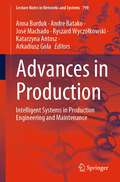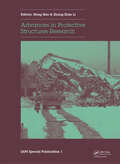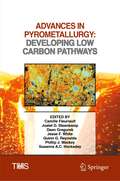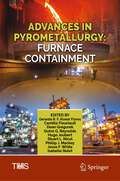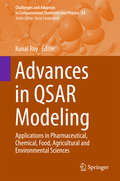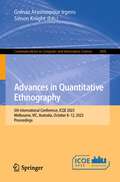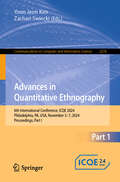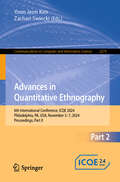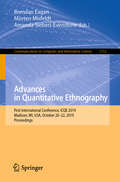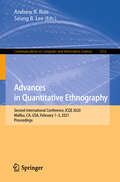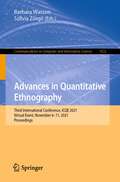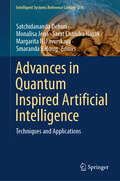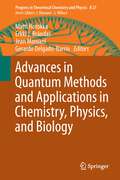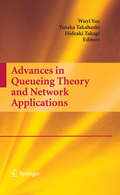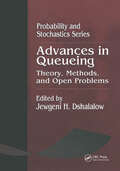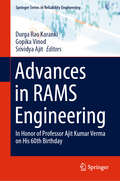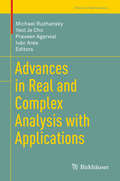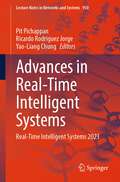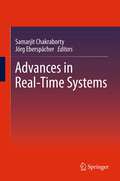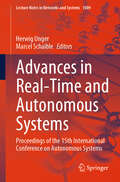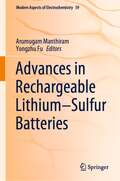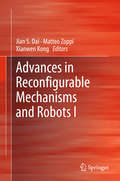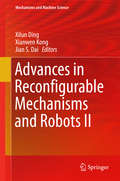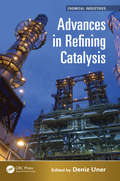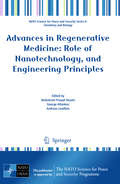- Table View
- List View
Advances in Production: Intelligent Systems in Production Engineering and Maintenance (Lecture Notes in Networks and Systems #790)
by Anna Burduk José Machado Andre Batako Arkadiusz Gola Ryszard Wyczółkowski Katarzyna AntoszThis book discusses the papers presented at Conference ISPEM 2023 which was organized by Wrocław University of Science and Technology, Liverpool John Moores University, and University of Minho. The conference gave an opportunity to exchange experiences in intelligent systems and tools in production, and maintenance, especially its practical application.
Advances in Protective Structures Research
by Hong Hao Zhong-Xian LiThe International Association of Protective Structures (IAPS) was launched on 1 October 2010 in Manchester, UK during the first International Conference of Protective Structures. The primary purpose of IAPS is to bring researchers and engineers working in the area of protective structures together, and to promote research and development work for b
Advances in Pyrometallurgy: Developing Low Carbon Pathways (The Minerals, Metals & Materials Series)
by Dean Gregurek Camille Fleuriault Jesse F. White Joalet D. Steenkamp Quinn G. Reynolds Phillip J. Mackey Susanna A.C. HockadayCarbon intensive industries are at a crossroads. Long-term manufacturing plans using pyrometallurgical processes all include decarbonization levers: we must solve the problem of fossil-based reduction and fossil-based power generation processes for metals production. This collection explores innovative and diverse strategies for the enablement of low carbon industries in the high-temperature metals and materials processing fields. In particular, the following processes are investigated:· Electrolysis and electrification of metallurgical processes · High-temperature electrolytic routes for metal and alloy production · Use of hydrogen and other alternative non-carbonaceous reducing agents · Biofuels and other non-fossil reagents for metallurgical applications · Direct and indirect use of solar energy in high-temperature processing · Energy efficiency and waste heat recovery concepts applied to pyrometallurgical operations
Advances in Pyrometallurgy: Furnace Containment (The Minerals, Metals & Materials Series)
by Dean Gregurek Camille Fleuriault Jesse F. White Quinn G. Reynolds Hugo Joubert Phillip J. Mackey Gerardo R. F. Alvear Flores Stuart L. Nicol Isabelle NoletThis collection explores the methods and challenges of containing corrosive and abrasive materials at extreme temperatures, whether they are used across commodities or technology specific. There is much to be learned from cross-commodity and cross-technology perspectives and this collection creates a platform for the exchange of ideas on the challenges, solutions, failures, and successes in furnace containment designs and applications while bringing together perspectives from industry, design houses, and research institutions. Topics include, but are not limited to: · Advances in furnace lining design philosophies · Advances in furnace design configurations and other design considerations · Problems experienced and their solutions implemented during construction and commissioning · Integration of new concepts into old smelters · Back to basics: refractory materials, shells, and cooling systems · Maintaining and monitoring · Process control and slag design · Lessons learned
Advances in QSAR Modeling: Applications in Pharmaceutical, Chemical, Food, Agricultural and Environmental Sciences (Challenges and Advances in Computational Chemistry and Physics #24)
by Kunal RoyThe book covers theoretical background and methodology as well as all current applications of Quantitative Structure-Activity Relationships (QSAR). Written by an international group of recognized researchers, this edited volume discusses applications of QSAR in multiple disciplines such as chemistry, pharmacy, environmental and agricultural sciences addressing data gaps and modern regulatory requirements. Additionally, the applications of QSAR in food science and nanoscience have been included - two areas which have only recently been able to exploit this versatile tool. This timely addition to the series is aimed at graduate students, academics and industrial scientists interested in the latest advances and applications of QSAR.
Advances in Quantitative Ethnography: 5th International Conference, ICQE 2023, Melbourne, VIC, Australia, October 8–12, 2023, Proceedings (Communications in Computer and Information Science #1895)
by Golnaz Arastoopour Irgens Simon KnightThis book constitutes the refereed proceedings of the 5th International Conference on Advances in Quantitative Ethnography, ICQE 2023, held in Melbourne, VIC, Australia, during October 8–12, 2023.The 33 full papers included in this book were carefully reviewed and selected from 39 submissions. They were organized in topical sections as follows: understanding learners and learning; society, culture, identity, and justice; and advances in QE methodologies.
Advances in Quantitative Ethnography: 6th International Conference, ICQE 2024, Philadelphia, PA, USA, November 3-7, 2024, Proceedings, Part I (Communications in Computer and Information Science #2278)
by Yoon Jeon Kim Zachari SwieckiThis two-volume set CCIS 2278-2279 constitutes the refereed proceedings of the 6th International Conference on Advances in Quantitative Ethnography, ICQE 2024, held in Philadelphia, PA, USA, during November 3-7, 2024. The 31 full papers and 10 short papers included in this book were carefully reviewed and selected from 82 submissions. They are organized in the following topical sections: Theory and Methods; Teaching and Learning; and Cultural Discourse.
Advances in Quantitative Ethnography: 6th International Conference, ICQE 2024, Philadelphia, PA, USA, November 3-7, 2024, Proceedings, Part II (Communications in Computer and Information Science #2279)
by Yoon Jeon Kim Zachari SwieckiThis two-volume set CCIS 2278-2279 constitutes the refereed proceedings of the 6th International Conference on Advances in Quantitative Ethnography, ICQE 2024, held in Philadelphia, PA, USA, during November 3-7, 2024. The 31 full papers and 10 short papers included in this book were carefully reviewed and selected from 82 submissions. They are organized in the following topical sections: Theory and Methods; Teaching and Learning; and Cultural Discourse.
Advances in Quantitative Ethnography: First International Conference, ICQE 2019, Madison, WI, USA, October 20–22, 2019, Proceedings (Communications in Computer and Information Science #1112)
by Brendan Eagan Morten Misfeldt Amanda Siebert-EvenstoneThis book constitutes the refereed proceedings of the First International Conference on Quantitative Ethnography, ICQE 2019, held in Madison, Wisconsin, USA, in October 2019. It consists of 23 full and 9 short carefully reviewed papers selected from 52 submissions. The contributions come from a diverse range of fields and perspectives, including learning analytics, history, and systems engineering, all attempting to understand the breadth of human behavior using quantitative ethnographic approaches.
Advances in Quantitative Ethnography: Second International Conference, ICQE 2020, Malibu, CA, USA, February 1-3, 2021, Proceedings (Communications in Computer and Information Science #1312)
by Andrew R. Ruis Seung B. LeeThis book constitutes the refereed proceedings of the Second International Conference on Quantitative Ethnography, ICQE 2020, held in February 2021. Due to the COVID-19 pandemic the conference has been postponed to 2021 and was held in online format. The 28 full papers were selected from 56 submissions. The contributions in this volume come from diverse fields and perspectives, and present the studies on advantages of using quantitative ethnography methods and techniques in a number of different domains and contexts, including ethnography and statistics, human interpretation and machine processing, etc.
Advances in Quantitative Ethnography: Third International Conference, ICQE 2021, Virtual Event, November 6–11, 2021, Proceedings (Communications in Computer and Information Science #1522)
by Barbara Wasson Szilvia ZörgőThis book constitutes the refereed proceedings of the Third International Conference on Quantitative Ethnography, ICQE 2021, held in November 2021. Due to the COVID-19 pandemic the conference was held online. The 26 full papers were selected from the 60 submissions. The contributions in this volume come from diverse fields and perspectives, and present the studies on advantages of using quantitative ethnography methods and techniques in a number of different domains and contexts, including ethnography and statistics, human interpretation and machine processing, etc.
Advances in Quantum Inspired Artificial Intelligence: Techniques and Applications (Intelligent Systems Reference Library #274)
by Satchidananda Dehuri Margarita N. Favorskaya Smaranda Belciug Monalisa Jena Sarat Chandra NayakThis book advances the artificial intelligence techniques by strongly inspired from quantum computing. Quantum computing (QC), rooted in the mysterious principles of quantum mechanics, has fascinated scientists, researchers, and visionaries for a long time. Its potential lies in changing how we compute, moving from classical bits to quantum bits (qubits), and unlocking incredible processing capabilities. At the same time, artificial intelligence (AI) has been on a trajectory of rapid advancement, with deep learning becoming proficient at tasks that were once deemed impossible. At this juncture, integrating these two fields through various means can play a pivotal role to bring a technological revolution.
Advances in Quantum Methods and Applications in Chemistry, Physics, and Biology (Progress in Theoretical Chemistry and Physics #27)
by Jean Maruani Erkki J. Brändas Gerardo Delgado-Barrio Matti HotokkaAdvances in Quantum Methods and Applications in Chemistry, Physics, and Biology includes peer-reviewed contributions based on carefully selected presentations given at the 17th International Workshop on Quantum Systems in Chemistry, Physics, and Biology. New trends and state-of-the-art developments in the quantum theory of atomic and molecular systems, and condensed matter (including biological systems and nanostructures) are described by academics of international distinction.
Advances in Queueing Theory and Network Applications (Lecture Notes In Mathematics #Vol. 755)
by Yutaka Takahashi Hideaki Takagi Wuyi YueAdvances in Queueing Theory and Network Applications presents several useful mathematical analyses in queueing theory and mathematical models of key technologies in wired and wireless communication networks such as channel access controls, Internet applications, topology construction, energy saving schemes, and transmission scheduling. In sixteen high quality chapters, this work provides novel ideas, new analytical models, and simulation and experimental results by experts in the field of queueing theory and network applications. The text serves as a state-of-the-art reference for a wide range of researchers and engineers engaged in the fields of queueing theory and network applications, and can also serve as supplemental material for advanced courses in operations research, queueing theory, performance analysis, traffic theory, as well as theoretical design and management of communication networks.
Advances in Queueing Theory, Methods, and Open Problems
by Jewgeni H. DshalalowThe progress of science and technology has placed Queueing Theory among the most popular disciplines in applied mathematics, operations research, and engineering. Although queueing has been on the scientific market since the beginning of this century, it is still rapidly expanding by capturing new areas in technology. Advances in Queueing provides a comprehensive overview of problems in this enormous area of science and focuses on the most significant methods recently developed.Written by a team of 24 eminent scientists, the book examines stochastic, analytic, and generic methods such as approximations, estimates and bounds, and simulation. The first chapter presents an overview of classical queueing methods from the birth of queues to the seventies. It also contains the most comprehensive bibliography of books on queueing and telecommunications to date. Each of the following chapters surveys recent methods applied to classes of queueing systems and networks followed by a discussion of open problems and future research directions.Advances in Queueing is a practical reference that allows the reader quick access to the latest methods.
Advances in RAMS Engineering: In Honor of Professor Ajit Kumar Verma on His 60th Birthday (Springer Series in Reliability Engineering)
by Srividya Ajit Durga Rao Karanki Gopika VinodThis book surveys reliability, availability, maintainability and safety (RAMS) analyses of various engineering systems. It highlights their role throughout the lifecycle of engineering systems and explains how RAMS activities contribute to their efficient and economic design and operation. The book discusses a variety of examples and applications of RAMS analysis, including: • software products; • electrical and electronic engineering systems; • mechanical engineering systems; • nuclear power plants; • chemical and process plants and • railway systems. The wide-ranging nature of the applications discussed highlights the multidisciplinary nature of complex engineering systems. The book provides a quick reference to the latest advances and terminology in various engineering fields, assisting students and researchers in the areas of reliability, availability, maintainability, and safety engineering.
Advances in Real and Complex Analysis with Applications (Trends in Mathematics)
by Michael Ruzhansky Yeol Je Cho Praveen Agarwal Iván AreaThis book discusses a variety of topics in mathematics and engineering as well as their applications, clearly explaining the mathematical concepts in the simplest possible way and illustrating them with a number of solved examples. The topics include real and complex analysis, special functions and analytic number theory, q-series, Ramanujan's mathematics, fractional calculus, Clifford and harmonic analysis, graph theory, complex analysis, complex dynamical systems, complex function spaces and operator theory, geometric analysis of complex manifolds, geometric function theory, Riemannian surfaces, Teichm#65533;ller spaces and Kleinian groups, engineering applications of complex analytic methods, nonlinear analysis, inequality theory, potential theory, partial differential equations, numerical analysis , fixed-point theory, variational inequality, equilibrium problems, optimization problems, stability of functional equations, and mathematical physics. It includes papers presented at the 24th International Conference on Finite or Infinite Dimensional Complex Analysis and Applications (24ICFIDCAA), held at the Anand International College of Engineering, Jaipur, 22-26 August 2016. The book is a valuable resource for researchers in real and complex analysis.
Advances in Real-Time Intelligent Systems: Real-Time Intelligent Systems 2023 (Lecture Notes in Networks and Systems #950)
by Pit Pichappan Ricardo Rodriguez Jorge Yao-Liang ChungThe current information society is transitioning to an intelligent society where real-world and real-data applications have a profound influence. Real-time computing has an enormous impact on the future information society. Unimaginable applications have been emerging in real-time applications in the last two years. Logical reasoning and inference-making activities by machines have become a reality. Complex and heterogeneous data are being processed and infused into machine intelligence, bringing machine intelligence equal to human intelligence. Real-time data and real-time intelligence are the crux of the current research. This book of 41 papers in real-time intelligent systems addresses various issues ranging from real-time algorithms to various applications in real-time intelligence. The contributions of this book will mark a significant impact in the near-future research in real-time intelligence.
Advances in Real-Time Systems
by Jörg Eberspächer Samarjit ChakrabortyThis volume contains the lectures given in honor to Georg Färber as tribute to his contributions in the area of real-time and embedded systems. The chapters of many leading scientists cover a wide range of aspects, like robot or automotive vision systems or medical aspects.
Advances in Real-Time and Autonomous Systems: Proceedings of the 15th International Conference on Autonomous Systems (Lecture Notes in Networks and Systems #1009)
by Herwig Unger Marcel SchaibleThe 15th International conference on "Autonomous Systems" is addressing an important topic for computing systems and communication networks due to increasingly complex environments they are working in. Therefore, this conferences addresses methods and solutions enabling such systems to independently adapt themselves to changed environmental conditions, are able to learn from different sources and to process external requests dependably, safely and timely. The solutions presented here range from hardware to system design to individual applications. The book contains the results of the researchers presented at this conference, which is supported by GI (German Society of informatics) and other organisations Real-Time Systems Expert Committees. The target audience is students and researchers in computer science and automation technology, engineers, programmers and users of automation and communication systems.
Advances in Rechargeable Lithium–Sulfur Batteries (Modern Aspects of Electrochemistry #59)
by Arumugam Manthiram Yongzhu FuThis book presents the latest advances in rechargeable lithium-sulfur (Li-S) batteries and provides a guide for future developments in this field. Novel electrode compositions and architectures as well as innovative cell designs are needed to make Li-S technology practically viable. Nowadays, several challenges still persist, such as the shuttle of lithium polysulfides and the poor reversibility of lithium-metal anode, among others. However over the past several years significant progress has been made in the research and development of Li-S batteries. This book addresses most aspects of Li-S batteries and reviews the topic in depth. Advances are summarized and guidance for future development is provided. By elevating our understanding of Li-S batteries to a high level this may inspire new ideas for advancing this technology and making it commercially viable. This book is of interest to the battery community and will benefit graduate students and professionals working in this field
Advances in Reconfigurable Mechanisms and Robots I
by Matteo Zoppi Jian S Dai Xianwen KongAdvances in Reconfigurable Mechanisms and Robots I provides a selection of key papers presented in The Second ASME/IFToMM International Conference on Reconfigurable Mechanisms and Robots (ReMAR 2012) held on 9th -11th July 2012 in Tianjin, China. This ongoing series of conferences will be covered in this ongoing collection of books. A total of seventy-eight papers are divided into seven parts to cover the topology, kinematics and design of reconfigurable mechanisms with the reconfiguration theory, analysis and synthesis, and present the current research and development in the field of reconfigurable mechanisms including reconfigurable parallel mechanisms. In this aspect, the recent study and development of reconfigurable robots are further presented with the analysis and design and with their control and development. The bio-inspired mechanisms and subsequent reconfiguration are explored in the challenging fields of rehabilitation and minimally invasive surgery. Advances in Reconfigurable Mechanisms and Robots I further extends the study to deployable mechanisms and foldable devices and introduces applications of reconfigurable mechanisms and robots. The rich-content of Advances in Reconfigurable Mechanisms and Robots I brings together new developments in reconfigurable mechanisms and robots and presents a new horizon for future development in the field of reconfigurable mechanisms and robots.
Advances in Reconfigurable Mechanisms and Robots II (Mechanisms and Machine Science #36)
by Xianwen Kong Xilun Ding Jian S. DaiThis book presents the most recent advances in the research and applications of reconfigurable mechanisms and robots. It collects 93 independently reviewed papers presented at the Third ASME/IFToMM International Conference on Reconfigurable Mechanisms and Robots (ReMAR 2015) held in Beijing, China, 20-22 July 2015. The conference papers are organized into seven parts to cover the reconfiguration theory, topology, kinematics and design of reconfigurable mechanisms including reconfigurable parallel mechanisms. The most recent results on reconfigurable robots are presented including their analysis, design, simulation and control. Bio-inspired mechanisms are also explored in the challenging fields of rehabilitation and minimally invasive surgery. This book further addresses deployable mechanisms and origami-inspired mechanisms and showcases a wide range of successful applications of reconfigurable mechanisms and robots. Advances in Reconfigurable Mechanisms and Robots II should be of interest for researchers, engineers and postgraduate students in mechanical engineering, electrical engineering, computer science and mathematics.
Advances in Refining Catalysis (Chemical Industries)
by Deniz UnerTo meet changing market demands that have stringent emission standards and to ensure proper performance in refinery units, evaluation of novel catalyst designs and results from material characterization and testing of catalysts are of crucial importance for refiners as well as for catalyst manufacturers. This book highlights recent developments in the application of refinery catalysts in selected units such as fluid catalytic cracking (FCC), hydrogen production for hydroprocessing units, hydrotreating, hydrocracking, and sustainable processing of biomass into biofuels.
Advances in Regenerative Medicine: Role Of Nanotechnology And Engineering Principles (NATO Science for Peace and Security Series A: Chemistry and Biology)
by Andreas Lendlein George Altankov Venkatram Prasad ShastriThe contributions to this book, all written by leading experts in their respective disciplines, describe and explore the various facets of regenerative medicine and highlight the role of the "the nano length scale" and of "nano-scale systems" in defining and controlling cell and tissue environments. The development of novel tissue-regeneration strategies requires the integration of new insights emerging from studies of cell-matrix interactions, cellular signalling processes, and developmental and systems biology, into biomaterials design, ideally via a systems approach. The chapters cover a wide spectrum of topics ranging from stem cell biology, developmental biology, cell-matrix interactions, and matrix biology to surface science, materials processing and drug delivery. The book will be an especially valuable resource for researchers developing regenerative medicine paradigms that combine these facets into clinically translatable solutions.
